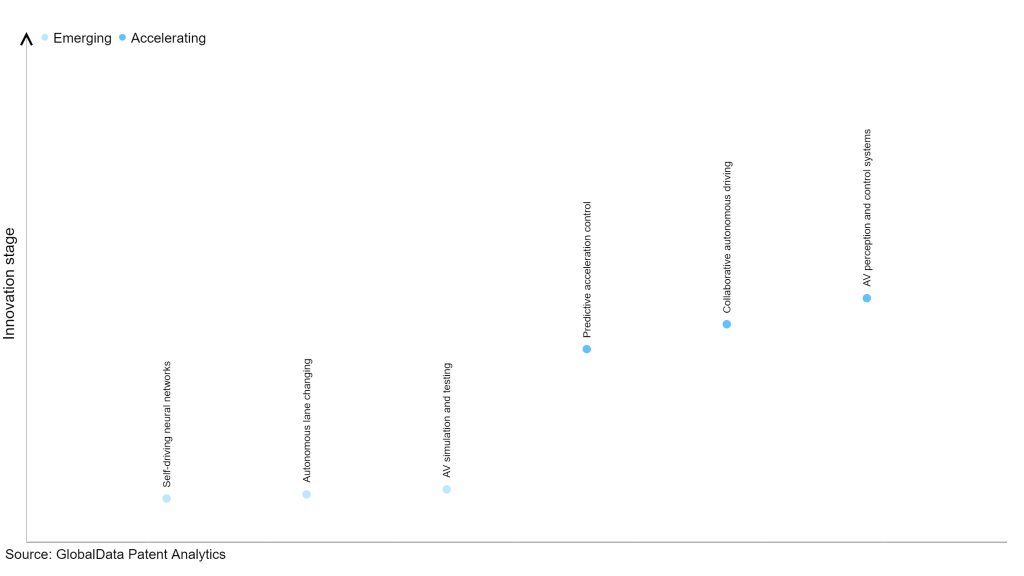The automotive industry continues to be a hotbed of patent innovation. Consumer demand for safety features in vehicles is driving the development of vehicular vision systems. These systems can detect and avoid pedestrians, cyclists, and other vehicles, monitor driver attention, and warn of drowsiness. Advances in sensor technology, software algorithms, government regulations, and increased competition are driving innovation in these systems. Examples include automatic emergency braking, lane departure warning, blind spot monitoring, adaptive cruise control, and night vision, which improve safety and performance in the automotive industry. LiDAR, radar, camera-based vision systems, and infrared vision are essential for autonomous driving. LiDAR uses pulsed laser light to measure distances to Earth, providing 3D information. Radar is less expensive, but more reliable. Camera-based systems capture images and use computer vision algorithms to identify objects. Infrared vision allows safe nighttime operation. In the last three years alone, there have been over 720,000 patents filed and granted in the automotive industry, according to GlobalData’s report on Artificial intelligence in automotive: vehicular vision. Buy the report here.
However, not all innovations are equal and nor do they follow a constant upward trend. Instead, their evolution takes the form of an S-shaped curve that reflects their typical lifecycle from early emergence to accelerating adoption, before finally stabilizing and reaching maturity.
Identifying where a particular innovation is on this journey, especially those that are in the emerging and accelerating stages, is essential for understanding their current level of adoption and the likely future trajectory and impact they will have.
300+ innovations will shape the automotive industry
According to GlobalData’s Technology Foresights, which plots the S-curve for the automotive industry using innovation intensity models built on over one million patents, there are 300+ innovation areas that will shape the future of the industry.
Within the emerging innovation stage, self-driving neural networks, autonomous lane changing and AV simulation and testing are disruptive technologies that are in the early stages of application and should be tracked closely. Predictive acceleration control, collaborative autonomous driving, and AV perception and control systems are some of the accelerating innovation areas, where adoption has been steadily increasing.
Innovation S-curve for artificial intelligence in the automotive industry

Vehicular vision is a key innovation area in artificial intelligence
Vehicular vision refers to the use of cameras and other imaging technologies in vehicles to improve safety and situational awareness for drivers and passengers. This can include cameras mounted inside and outside of the vehicle, as well as image processing and data analysis techniques to identify objects, hazards, and other important information.
GlobalData’s analysis also uncovers the companies at the forefront of each innovation area and assesses the potential reach and impact of their patenting activity across different applications and geographies. According to GlobalData, there are 250+ companies, spanning technology vendors, established automotive companies, and up-and-coming start-ups engaged in the development and application of vehicular vision.
Key players in vehicular vision – a disruptive innovation in the automotive industry
‘Application diversity’ measures the number of applications identified for each patent. It broadly splits companies into either ‘niche’ or ‘diversified’ innovators.
‘Geographic reach’ refers to the number of countries each patent is registered in. It reflects the breadth of geographic application intended, ranging from ‘global’ to ‘local’.
Patent volumes related to vehicular vision
Source: GlobalData Patent Analytics
LG is one of the leading patent filers in vehicular vision, including cameras, sensors, software, and systems. The company's latest patent uses artificial intelligence to detect and identify road objects. LG's patents are used to develop new features for its vehicles and license to other automakers, making roads safer for everyone. Some other key patent filers in this space are Panasonic and Aisin.
In terms of application diversity, Stella Vermogensverwaltungs leads the pack. Texas Instruments and Kyocera stood in the second and third positions, respectively. By means of geographic reach, BAE Systems held the top position, followed by Sumitomo Electric and Intel.
To further understand the key themes and technologies disrupting the automotive industry, access GlobalData’s latest thematic research report on Artificial Intelligence (AI) in Automotive.
Data Insights
From

The gold standard of business intelligence.
Blending expert knowledge with cutting-edge technology, GlobalData’s unrivalled proprietary data will enable you to decode what’s happening in your market. You can make better informed decisions and gain a future-proof advantage over your competitors.



